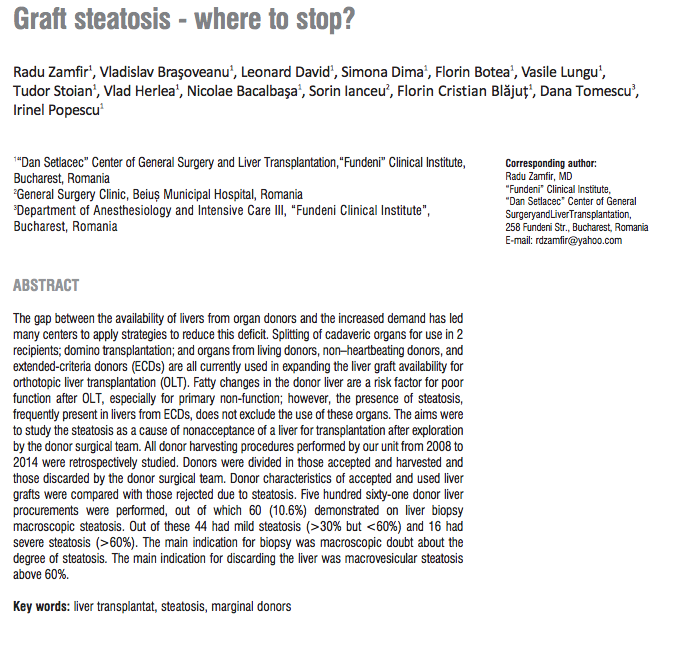Autori:
Radu Zamfir*, Vladislav Braşoveanu*, Leonard David*, Simona Dima*, Florin Botea*, Vasile Lungu*, Tudor Stoian*, Vlad Herlea*, Nicolae Bacalbaşa*, Sorin Ianceu**, Florin Cristian Blăjuţ*, Dana Tomescu***, Irinel Popescu*
*“Dan Setlacec” Center of General Surgery and Liver Transplantation,“Fundeni” Clinical Institute, Bucharest, Romania
**General Surgery Clinic, Beiuæ Municipal Hospital, Romania
***Department of Anesthesiology and Intensive Care III, “Fundeni Clinical Institute”, Bucharest, Romania
**General Surgery Clinic, Beiuæ Municipal Hospital, Romania
***Department of Anesthesiology and Intensive Care III, “Fundeni Clinical Institute”, Bucharest, Romania
Rezumat:
The gap between the availability of livers from organ donors and the increased demand has led many centers to apply strategies to reduce this deficit. Splitting of cadaveric organs for use in 2 recipients; domino transplantation; and organs from living donors, non–heartbeating donors, and extended-criteria donors (ECDs) are all currently used in expanding the liver graft availability for orthotopic liver transplantation (OLT). Fatty changes in the donor liver are a risk factor for poor function after OLT, especially for primary non-function; however, the presence of steatosis, frequently present in livers from ECDs, does not exclude the use of these organs. The aims were to study the steatosis as a cause of nonacceptance of a liver for transplantation after exploration by the donor surgical team. All donor harvesting procedures performed by our unit from 2008 to 2014 were retrospectively studied. Donors were divided in those accepted and harvested and those discarded by the donor surgical team. Donor characteristics of accepted and used liver grafts were compared with those rejected due to steatosis. Five hundred sixty-one donor liver procurements were performed, out of which 60 (10.6%) demonstrated on liver biopsy macroscopic steatosis. Out of these 44 had mild steatosis (>30% but <60%) and 16 had severe steatosis (>60%). The main indication for biopsy was macroscopic doubt about the degree of steatosis. The main indication for discarding the liver was macrovesicular steatosis above 60%.
Publicat:
Publicat:
J. Transl. Med. Res 2015;20(2):67-70
[gview file=”https://www.chirurgiehbp.ro/wp-content/uploads/2016/08/2015-2-67.pdf”]

